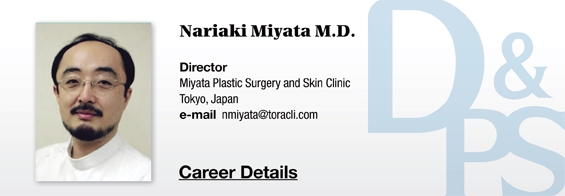
Injectable dermal fillers came a long way from the atelocollagen fillers in the early days to various ingredients such as hyaluronic acid (HA) or calcium hydroxyapatite (CaHA). Absorbable fillers are preferred in Japan and semi-permanent fillers are rarely used. Polylactic acid (PLLA)is also rarely used. Currently, the most widely used filler ingredients are HA, CaHA and Japan-produced bovine atelocollagen.
Bovine atelocollagen is effective in fine wrinkle correction. Doctors who have long used atelocollagen do not mind the inconvenience of performing pre-treatment allergy test due to its excellent effect. Atelocollagen has unique benefits that cannot be achieved with HA. It takes a special place in the practice of many Japanese plastic surgeons who are experienced in making a series of injections millimeters apart into the upper dermis. As it injects collagen, the very component of dermis, it is highly biocompatible and allows precise injection. Most doctors have, however, transitioned to HA with better moldability and less cross-linking.
[Advertisement] A-One LITE(Facial Diagnosys System) – Manufacturer: BOMTECH(www.bomtech.net)
HA is a popular dermal filler material in Japan. Allergan’s Juvederm Vista Ultra and Juvederm Vista Ultra Deep have been recently approved by the Japanese health authority. These two products do not contain anesthetics such as xylocaine. Japan has fewer dermal filler types available compared to the rest of the world. However, Japanese doctors can personally import unapproved medical products. As the above product could not be imported during the approval application period, Q-MED’s Restylane or Teoxane’s Teosyal currently have large market shares. Various manufacturers throughout the world produce HA fillers and a wide variety of filler products are available to suit the doctor’s individual preferences and price ranges. Doctors do not select fillers only based on the price, however, and products with poor quality or fake products are not used.
As products from manufacturers other than Allergan have not been approved in Japan yet, it seems Juvederm products will become the mainstay of filler procedures in the near future. As the approval process is drawn out and costly, only a few manufacturers with large market shares will apply for approval.
Dermal fillers are generally injected into age-related indentation such as nasolabial folds, mid cheek grooves, or lower eyelids (including tear trough grooves). Particularly, Asians use fillers to elevate the nose bridge and contour the chin. In the past, most filler injections focused on local filling of indented areas, but new techniques such as ‘volumizing lift’ have been developed for the aging population who desire to restore facial volume. Following overseas reports on this new technique, many studies on age related volume reduction have been conducted in Japan. Various new injection methods have been proposed for facial contouring. However, the interest and recognition of facial contouring is still low in Japan and the most widely performed treatment is still local injections. Moreover, Japanese doctors shy away from international academic conferences due to language barrier and rely on domestic data. They are reluctant to adapt to new techniques in the field.




















